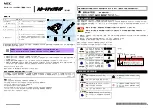
38
Appendix D: Glossary
Wireless-G USB Network Adapter with SpeedBooster
OFDM
(Orthogonal Frequency Division Multiplexing) - A type of modulation technology that separates the data
stream into a number of lower-speed data streams, which are then transmitted in parallel. Used in 802.11a,
802.11g, and powerline networking.
Packet
- A unit of data sent over a network.
Passphrase
- Used much like a password, a passphrase simplifies the WEP encryption process by automatically
generating the WEP encryption keys for Linksys products.
Port
- The connection point on a computer or networking device used for plugging in a cable or an adapter.
Roaming
- The ability to take a wireless device from one access point's range to another without losing the
connection.
Router
- A networking device that connects multiple networks together, such as a local network and the Internet.
RTS
(Request To Send) - A packet sent when a computer has data to transmit. The computer will wait for a CTS
(Clear To Send) message before sending data.
Server
- Any computer whose function in a network is to provide user access to files, printing, communications,
and other services.
Software
- Instructions for the computer. A series of instructions that performs a particular task is called a
“program”.
Spread Spectrum
- Wideband radio frequency technique used for more reliable and secure data transmission.
SSID
(Service Set IDentifier) - Your wireless network's name.
Subnet Mask
- An address code that determines the size of the network.
Switch
- Device that is the central point of connection for computers and other devices in a network, so data can
be shared at full transmission speeds.
TCP/IP
(Transmission Control Protocol/Internet Protocol) - A network protocol for transmitting data that requires
acknowledgement from the recipient of data sent.
WEP
(Wired Equivalent Privacy) - A method of encrypting data transmitted on a wireless network for greater
security.






































